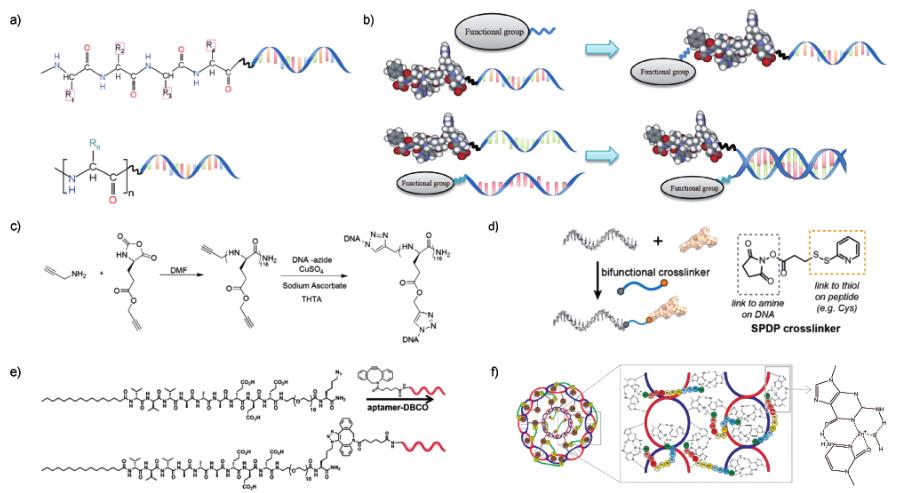DNA-Peptide Composite Molecules
As a new type of self-assembled molecule, DNA-peptide composite molecules have received widespread attention from researchers. DNA molecules have advantages such as programmability, high specificity, and diverse functions. Peptide molecules are an important class of small biomolecules that can form nanomaterials with different structures through molecular self-assembly. Therefore, by covalent crosslinking, DNA peptide composite molecules with multi-level self-assembly behavior can be obtained, which can achieve integrated optimization of the functions of two important biomolecules, Synthesis of supramolecular self-assembly materials with different structures and function.
What is peptide?
Peptides are important active substances in living organisms, formed by the binding of various amino acids through peptide bonds in a certain order. Peptide molecules in nature spontaneously form nano assemblies through molecular recognition in living organisms. Drawing inspiration from the molecular self-assembly phenomenon in biological systems, scientists have constructed various morphologies of nanostructures, including nanotubes, nanofibers, nanohelices, etc., through rational design of peptide sequences, selection of sensitive connecting bonds, and regulation of their self-assembly behavior, in biomedical, sensing, and optical devices. Omizzur ltd provide services of custom peptide synthesis .
What is DNA?
DNA can form complex and finely controllable self-assembled materials from bottom to top through molecular self-assembly. DNA has precise base recognition interactions, sequence designability and programmability, as well as clear secondary structures. In addition to mature chemical solid-phase synthesis and modification technologies, DNA has quickly become a highly versatile molecular module for constructing precise, complex, and dynamic nanostructures and molecular networks. These supramolecular structures can be used as templates to precisely regulate the growth and orderly assembly of proteins, inorganic materials and nanoparticles.
DNA Polymer Composite Molecules
In recent years, the design and assembly of DNA polymer composite molecules have received widespread attention from researchers. The DNA functionalization of polymers can provide an additional level of control over material structure and macroscopic properties, making it possible to construct stimulus responsive materials. At present, DNA polymers have been used to prepare hydrogels and other nano materials, drug delivery systems, light-emitting materials and electronic devices.
Co-assembly of peptides and DNA molecules
At present, there have been numerous reports on the use of weak or electrostatic interactions between molecules to regulate the co assembly of peptides and DNA molecules, used to construct functional materials such as viral nanoparticles, which have good application characteristics in the fields of biomedicine and sensing detection. However, there are still relatively few studies on the use of covalent bond to connect polypeptides with DNA molecules, design DNA peptide composite molecules, and regulate their self-assembly to form multi-level ordered functional materials, which is one of the research frontiers in the field of supramolecular self-assembly.
Design of DNA-peptide composite molecules
At present, the synthesis of DNA and peptide molecules involves connecting shorter DNA strands or nucleic acids to peptide chains. The design of DNA peptide molecules can be divided into two categories: the binding of DNA chain polymer peptides and the binding of DNA chain to short peptides. Polymer peptides refer to homopolymers or copolymers with high polymer chains obtained through covalent polymerization of one or more amino acids or their derivatives. Short peptides are formed by dehydration and condensation of multiple amino acids, and the peptide chain is generally less than 10 amino acid residues. The binding between DNA and polymer peptides is carried out using peptides as the backbone and DNA as the side chains for grafting.
DNA can not only serve as a modifying molecule to provide localization, recognition, and other functions, but also as a crosslinking agent to connect peptides to form supramolecular network structures. The binding between DNA and short peptides has been reported in literature, where DNA is linked to the end of the polypeptide chain through cross-linking agents. The polypeptide chain serves as the framework for supramolecular self-assembly, while DNA serves as the recognition component for further structural regulation. In addition, introducing functional groups into DNA peptide composite molecules can also make them have different functions. Functional groups can be connected to one end of the peptide or to the peptide chain through complementary DNA ends.

(a) Structural schematic diagrams of DNA short peptide composite molecules and DNA polymer peptide composite molecules;
(b) Two methods for introducing functional groups into DNA peptide composite molecules
(c) Synthesis Route of PPLG g-DNA Molecular Brush
(d) Synthesis of DNA peptide complexes using bifunctional crosslinking agents
(e) Crosslinking reaction between cyclic octyne modified oligonucleotides and amphiphilic peptides terminated with azide lysine
(f) Functional Peptides and DNA Molecular Structure by Ligand Metal Charge Transfer
Omizzur fast link: >> Peptide impurity synthesis
Copyright © 2020 Omizzur Inc | Terms & Conditions | Privacy Notice | Sitemap